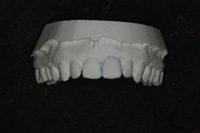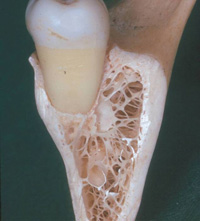Doctor, thank you for your time today. You did a wonderful job of explaining the complex treatment that I need. I’ve been thinking about what you said at the examination and what will happen if I don’t take care of my problems in a timely manner. I’ve decided to go ahead and have it all done…just the way you laid it out today.”
Fast forward 3 weeks later. You join Tuesday’s morning meeting to find that Mr. Robinson is scheduled for just two amalgams today. This can’t be true, there must be a mistake. Mr. Robinson has multiple crowns and two bridges. Why is he scheduled to begin his extensive treatment with two small amalgams? You look at the administrative staff in consternation. “What happened?” you ask.
FINANCIAL OPTIONS GUARANTEED TO SABOTAGE QUALITY SCHEDULING
Pay as You Go
This option requires patients to bring in an amount of money that covers the total dentistry to be delivered that day. For crown and bridgework and prostheses, this option is often adjusted to “half down at the prep and the balance at the cement/deliver.”
Cons: Running a pay-as-you-go practice, which seems quite the norm across the country, is full of potential problems. When money is tied into appointments, the policy results in:
(1) Encouraging no-shows and cancel short notices. When the patient’s car dies, the mechanic won’t repair and return the car without the $1,000 bill paid. I can guarantee that the car taking the patient to work takes precedence over dentistry, 85% of which is elective.
(2) Encouraging multiple short appointments. Your daily schedule reflects patients’ financial limitations as your days are comprised of many small appointments rather than fewer and longer appointments. A patient needing eight crowns conceivably could book eight prep and eight cement appointments. That is 16 appointments by my mathematics.
(3) Greatly increasing stress for the doctor and clinical staff and increasing overhead as you prepare many more rooms for these extra appointments.
(4) Greatly increasing stress and decreasing efficiency in the administrative area. Increased patient flow at the front desk reduces both the quality of time administrative staff spends with each patient as well as the ability to handle important administrative duties such as collection calls, etc.
Half Down and Three Equal Payments
I ask that you re-read the Pay-as-You-Go option, in the light of the following statistic. According to Bank One of Ohio, 93% of American consumers who commit and sign that they’ll pay off a debt within 90 days renege on their commitment. Let’s give this option the name it should be known by: “an interest-free 90-day loan.”
Mailing Statements and Praying
This approach is prevalent in areas of the country where practices have a very stable base of patients who have been coming to the doctor for years. The relationship between patient and practice has become casual, everyone feels very comfortable, and concise financial agreements don’t seem to be a high priority in practice-patient communication. This payment method can be insidious to effective scheduling, because over time, when the staff become nervous about extending credit after suffering some high write-offs, they schedule shorter and shorter appointments.
Electronic Transfer
Strongly recommended by some consultants and speakers, I have a different take on this option. Electronic transfers shift funds to the doctor’s bank account from either the patient’s bank account or from the patient’s credit card. Both systems are suspect. There is no guarantee that there will be funds in the bank when the transfer is processed, which is usually after treatment has been rendered. There is also no guarantee that there will be available credit on the card (see Retail Credit Card section for more background on consumers’ available credit). Electronic transfer, in my opinion, is another phrase for Pay as You Go, and is accompanied by the same scheduling limitations outlined elsewhere in this article.
FINANCIAL OPTIONS STRONGLY SUPPORTING PRODUCTIVE SCHEDULING
Prepay
This method involves patients paying their entire financial responsibilities prior to treatment. I find that the majority of dental offices offering this choice to their patients don’t fully comprehend either the full extent of the benefits or the potential major pitfalls of this payment method.
Pros: It’s hard to overemphasize the benefits this payment method offers in the delivery of scheduling quality days.
(1) No-shows and cancel short notices are virtually eliminated. It is amazing how patients remember their appointments when their money is in your bank account.
(2) Multiple short appointments disappear from your schedule. With payment being a non-issue, the practice can schedule fewer but much longer appointments. This provides quality clinical time for both doctor and patient.
(3) Quality administrative time is now provided for staff to take care of their responsibilities, which are always being put off because of telephone/people activity at the front desk. As the hotel owner in the famous classic British comedy series Fawlty Towers says: “This hotel would run really well if we just didn’t have to deal with the guests.” This is how many administrative staff feel about patients, as they never get protected time to handle and monitor the myriad of administrative duties.
(4) Overhead is reduced when fewer rooms need to be cleaned and prepared.
(5) Today’s busy patients genuinely appreciate more dentistry delivered in less visits. It makes their lives easier.
Cons: There are three major problems potentially created when using this payment option. The good news is that once a practice has been put on notice as to the weaknesses of this method, pro-active measures can be taken to ensure that none of the following three problems occur:
Problem No. 1. Patients have an amazing ability to believe that a dental estimate is a guarantee of a fixed price. When the buccal pit becomes a three-rooted endo and a crown, many patients just don’t seem to understand why the money, which they’ve already paid the doctor, doesn’t cover the additional treatment. If the situation is not handled professionally and openly, the relationship built on confidence and trust can erode as the patients get confused and upset at changes they don’t understand.
Problem No. 2. When treatment plans change for patients with a large credit balance, problems can result if communication between doctor and administrative staff is not at the highest level. The solution to this problem is to raise the level of communication among doctor, patient, and team to guarantee that any treatment changes are both fully explained to and accepted by the patient, and the clinical and financial changes are fully reflected throughout the patient’s clinical and financial records.
Problem No. 3. In the majority of practices, patients are quoted a bookkeeping savings of 5% to encourage them to prepay. I am a fan of this service to patients as long as the insurance billing reflects the actual monies paid by the patient to the practice. This keeps a practice on the right side of the law. However, problems can result if the patient accepting the adjustment amount is told by the practice to bring the total amount on the first treatment visit. The patient is scheduled for extensive dentistry. The administrative staff hold their breath at the front desk, hoping the patient has kept their word and brought in the agreed upon amount. The patient is dismissed from the clinical area, walks to the front desk, and when asked for money, looks the administrative staff in the eye and says, “Oh, was I supposed to bring in the money today?”
After several follow-up phone calls (and a great deal of stress experienced by the team) the patient arrives for the next appointment. The patient may or may not have the money! Several more telephone calls and some weeks later, the money finally arrives through the mail. And, you’ve guessed it, the check is written out for the “discounted” amount, an amount an office can’t afford to really accept if they’re going to experience these collection problems and the accompanying stress involved.
(1) Patients were educated that the cost of dentistry—once quoted—never changed, which established a precedent in the patient’s mind that I felt could create more problems in the future, when treatment did change and the 10% approach was not used.
(2) Patients whose treatment remained as estimated were charged 10% more, regardless.
(3) Patients whose planned three-rooted endo and a crown became less extensive were still charged for the more expensive treatment.
I personally felt that this was not a fair approach for either patient or practice. With the advent of insurance billing and the need for the office to specifically tie treatment to an insurance billing code, the concept of total billing became unworkable for the majority of offices, but I still come across this system once in awhile.
Retail Credit Card
In theory, one assumes this option to be a powerful tool for supporting quality appointment scheduling. Unfortunately, that’s not usually the case.
Pros: (1) The money is in your bank account by the next banking day.
(2) You incur no administrative collection costs for staff to telephone and write for past-due monies.
(3) Assuming your staff always get authorization when the charge amount is over your “floor limit” and process charges in a timely manner, the money is guaranteed.
Bottom line: Unless your office subscribes to one of the check guarantee services, any check presented to you by a patient has the potential of bouncing. Personally, I can’t think of any negatives of using a retail credit card.
Two potential cons: (1) Some dentists still see merchant account costs as a negative; I don’t agree with this line of thinking. Let’s re-read the benefits of using MasterCard and Visa, and analyze all the administrative and potential collection costs from which you’ve been protected. Balance that against your merchant account fees, and I think you will find that you are in a credit situation.
(2) The average American consumer has $450 available credit on their MasterCard/Visa. That line of credit won’t make much of a dent in enabling a patient to charge extensive treatment. Potentially, a practice is now back in the pay-as-you-go method of providing treatment and extending credit through monthly in-office payment plans. Both of these options put the doctor at financial risk.
Bottom line: Should you contemplate terminating being a merchant because of the limited funds available to the average consumer? Absolutely not. Just don’t plan on the majority of your patients financing major dentistry through their MasterCard and Visa. The cards, however, work extremely well for charging lesser treatment. Again, I don’t see any negatives tied into this service. (Please note the previous discussion on the use of credit card electronic transfers and major concerns about using these cards for this type of payment option.)
Outside Financing
Along with prepayment, this option goes to the top of the list. Patients can get approved for dental financing within 30 to 60 seconds.
Pros: Like prepayment, the practice no longer has to worry about tying money into each appointment. Outside financing therefore fully supports quality scheduling. Patients, once approved, can make small monthly payments to the finance company, and the practice can schedule appointments based on the patient’s clinical needs, not her checkbook. It is a win-win for all the players.
Cons: (1) I can guarantee there is always one person in a seminar who will raise his hand and say, “Oh, I tried so-and-so financing program and it doesn’t work. Patients get turned down!”
(2) Healthcare financing, eg, CareCredit, is set up to charge the patient’s line of credit after treatment is rendered. The chances of misunderstanding when changes in treatment take place are eliminated. A practice therefore needs to be most careful when using an outside finance company that prepays the estimated treatment amount to the practice prior to treatment. In this case you can experience the same potential pitfalls described in the prepay problem section.
(3) Unless you are prepared to charge your patients a finance fee on past-due accounts, outside financing will be a hard sell for your staff. Why would a patient get excited about paying interest on borrowed money when they can get the same money from you for free? The top patient financing companies offer doctors the ability to offer patients interest-free plans. Please don’t! I hear you say, “But that means I’ll have to pay the finance company an extra discount rate!” Please don’t worry about it. The increased treatment acceptance rate by your patients will make that overhead cost a non-issue.
YOUR CONSULTATION APPOINTMENT: THE KEY TO QUALITY SCHEDULING
We can’t talk about an office offering the best financial choices for patients without discussing one of my biggest areas of concern in practice-patient communication. When the consultation appointment is mishandled, I will guarantee that you compromise quality scheduling.
I feel it is essential for the doctor and patient at the consultation to be joined by the administrative staff member responsible for closing the financial commitment from the patient. As long as practices continue to exclude the financial coordinator from the consultation process, practices will continue to experience patients saying “yes” to total treatment to the doctor during the consultation, yet saying “no” to the same treatment to administrative staff at the front!
- Education regarding a patient’s proposed treatment, dentistry in general, and the doctor’s philosophies specifically.
- Hearing any concerns/limitations a patient may voice, and learning the doctor’s solutions/answers for patient concerns.
- Observing the level of patient interest in receiving treatment, and analyzing the support, or lack of support, from an attending spouse or a partner.
When your administrative staff is excluded from this meeting, they work at an enormous disadvantage in follow-up patient communication. Trying to work with the patients to get a financial commitment for treatment about which they aren’t educated is a recipe for disaster. For the smaller practices with just one team member on the front desk, you have just died! Who is going to answer the phones and release patients while that team member is off the front desk and holed up somewhere else in the office. My opinion on this scenario is that these offices are most probably understaffed in the administrative area.
The following statistics don’t happen when we have one staff member trying to do everything: (a) 105%+ collection ratio; (b) stress-free days when the doctor runs on or ahead of schedule; and (c) 95%+ patients pre-book hygiene.
MONITORING FOR SUCCESS
Doctor, an essential part of you being on top of, and in control of, what is happening in your practice is taking responsibility for having your staff prepare, and for you to read, your New Patient monthly report. Computer software companies tell us that the average dental practice uses 20% or less of the software package dentists purchase. Staff routinely tell consultants that the computer-generated reports get short shift from the majority of dentists.
The two key statistics are:
(1) Column 5—total treatment $ diagnosed and presented to patients.
(2) Column 6—treatment $ accepted by patients.
The following three columns are part and parcel of column 5 and 6 integrated:
(3) Column 7—dental insurance coverage (does patient have one or two coverages).
(4) Column 8—financial option chosen.
(5) Column 9—appointment made (or see following).
The last two columns show the number of patients in a holding pattern (“Let me go home and think about it” or “send it to the insurance company and see what they’ll pay”) versus those ready to move forward with treatment: Column 10, TF Date (delaying treatment and registered in the Tickler File) and Column 11, Continuing Care Date.
Totals listed at the bottom of the page give you a quick overview. I’d like to see two more statistics included in the total line:
- _% of treatment diagnosed (goal 70%+).
- _% of new patients saying yes to treatment (goal 70%+).
Many top consultants closely monitoring their clients’ statistics find that doctors who don’t use this monitoring tool routinely are under the impression they have a 70% treatment acceptance rate. They are horrified to find that in reality the acceptance rate is closer to 35%. Become proactive in your management, not reactive.
SUMMARY
To schedule quality, stress- free days, a dentist needs to provide a range of effective financial options for patients that allows them the ability to prepay in full or make small monthly payments to an outside finance company. The choice is the patient’s. Both options benefit the patient/
dentist relationship.
Ms. de St. Georges is an internationally renowned dental practice management educator and a member of the National Speaker’s Association. She serves as a contributing editor for Dentistry Today, the first non-dentist to be named to this position. To request Ms. de St. Georges’ speaking schedule, book her to speak for your association/group, or purchase an audiotape program, please contact Vickey Saia at (800) 366-7004. Mention code 0209 to enjoy a $25 saving for Dentistry Today readers. Ms. de St. Georges maintains JdSG International Inc in Monte Sereno, Calif, and can be reached at (800) 366-7004 or info@jdsg.com.











